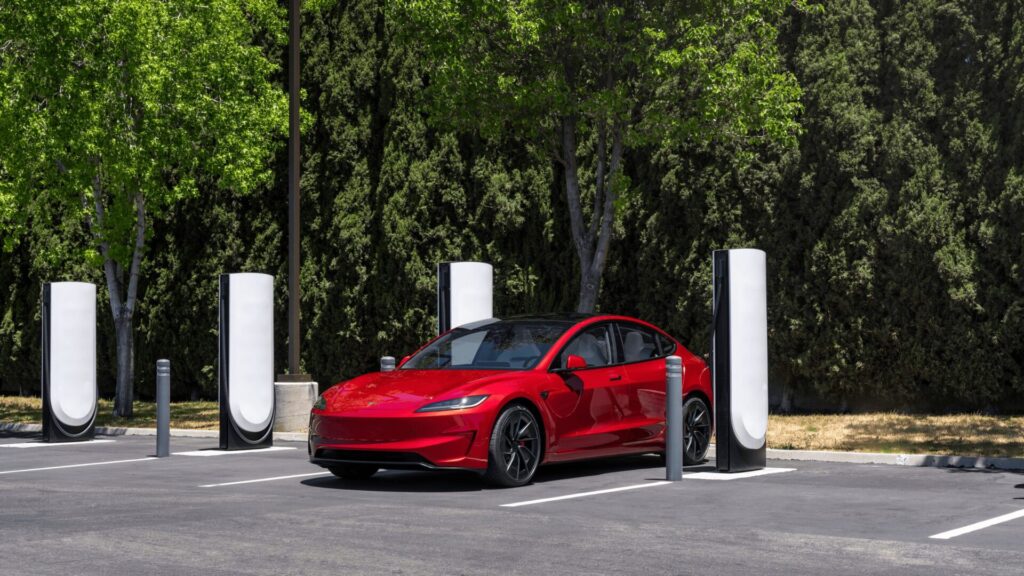Tesla has reached a significant milestone in Supercharger network usage, with an average of 587,000 charging sessions per day worldwide during the third quarter of 2025. This figure is nearly triple what the company saw just two and a half years ago, showcasing the growing global adoption of electric vehicles and the utilization of Tesla’s charging infrastructure.
The data, shared by longtime Tesla observer Sawyer Merritt on X, highlights the increasing popularity of the Supercharger network among both Tesla and non-Tesla electric vehicles. While Tesla did not provide a breakdown of how many of these charging sessions were from Tesla vehicles versus other EVs utilizing its open-access program, the overall trend indicates a surge in demand for electric vehicle charging solutions.
This milestone comes on the heels of Tesla’s Q3 2025 production and delivery results, where the company reported opening a record 4,000 new Supercharger stalls during the quarter. This expansion has pushed Tesla’s global Supercharger count to new heights as it continues to deploy charging stations across North America, Europe, and Asia to meet the growing demand for electric vehicle infrastructure.
In addition to the increased usage of the Supercharger network, Tesla achieved another major milestone during Q3 with the launch of the world’s first 500kW, fully V4 Supercharger site in Redwood City, California. This new location features upgraded V4 charging cabinets and stalls capable of faster and more efficient charging, catering to vehicles like the Cybertruck and future models.
Furthermore, Tesla has been expanding its visibility by advertising Supercharger locations on highway signs in the U.S. for the first time, signaling a more integrated approach to national EV infrastructure. This move aims to make Tesla’s charging network more accessible and visible to a wider audience, further solidifying its position in the electric vehicle market.
On the vehicle delivery side, Tesla delivered a record 497,099 units in Q3 2025, showcasing strong demand for its electric vehicles globally. With the company’s next earnings report on the horizon, more details about its charging and delivery performance are expected to be revealed, providing further insights into Tesla’s growth and success in the EV market.
As Tesla continues to innovate and expand its Supercharger network, the company remains at the forefront of the electric vehicle revolution, driving towards a more sustainable and efficient future for transportation. Stay tuned for more updates on Tesla’s Q3 2025 results later this month. The Benefits of Mindful Eating
In today’s fast-paced world, it can be easy to rush through meals without giving much thought to what we’re eating or how we’re eating it. However, practicing mindful eating can have numerous benefits for both our physical and mental health. By paying attention to what we’re eating, how we’re eating it, and how it makes us feel, we can develop a healthier relationship with food and improve our overall well-being.
One of the main benefits of mindful eating is that it can help us become more aware of our hunger and fullness cues. By paying attention to our body’s signals, we can avoid overeating and better regulate our food intake. This can be especially helpful for those trying to lose weight or maintain a healthy weight. Mindful eating can also help us better appreciate the flavors and textures of our food, allowing us to savor each bite and derive more pleasure from our meals.
In addition to helping us better regulate our food intake, mindful eating can also improve our digestion. By eating slowly and chewing our food thoroughly, we can aid in the digestion process and reduce the chances of experiencing digestive issues such as bloating or indigestion. This can lead to better nutrient absorption and overall improved gut health.
Furthermore, practicing mindful eating can help us develop a healthier relationship with food. By being present and attentive while eating, we can tune into our body’s needs and cravings, rather than relying on external cues or emotional triggers. This can help us break free from unhealthy eating patterns and make more informed food choices that align with our body’s needs.
Mindful eating can also have a positive impact on our mental health. By focusing on the present moment and paying attention to our food, we can reduce stress and anxiety levels. This can lead to a greater sense of calm and relaxation during meals, as well as improved overall mental well-being.
To practice mindful eating, start by setting aside dedicated time for meals without distractions such as screens or work. Take the time to appreciate the appearance, aroma, and taste of your food. Chew slowly and savor each bite, paying attention to the sensations and flavors in your mouth. Listen to your body’s hunger and fullness cues, and stop eating when you feel satisfied rather than full.
In conclusion, mindful eating can have numerous benefits for our physical and mental health. By paying attention to what we’re eating and how we’re eating it, we can develop a healthier relationship with food, improve our digestion, regulate our food intake, and reduce stress levels. So next time you sit down for a meal, try practicing mindful eating and see how it can positively impact your overall well-being.

